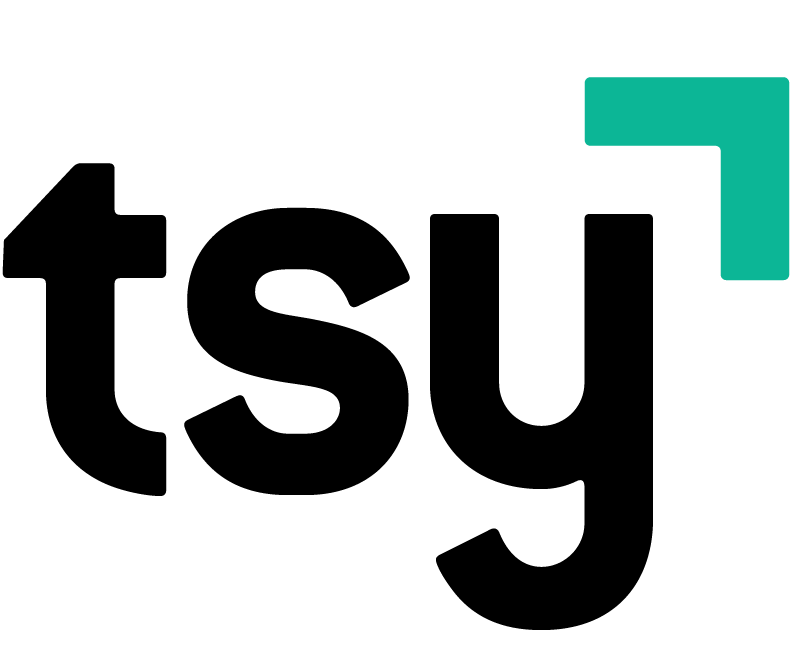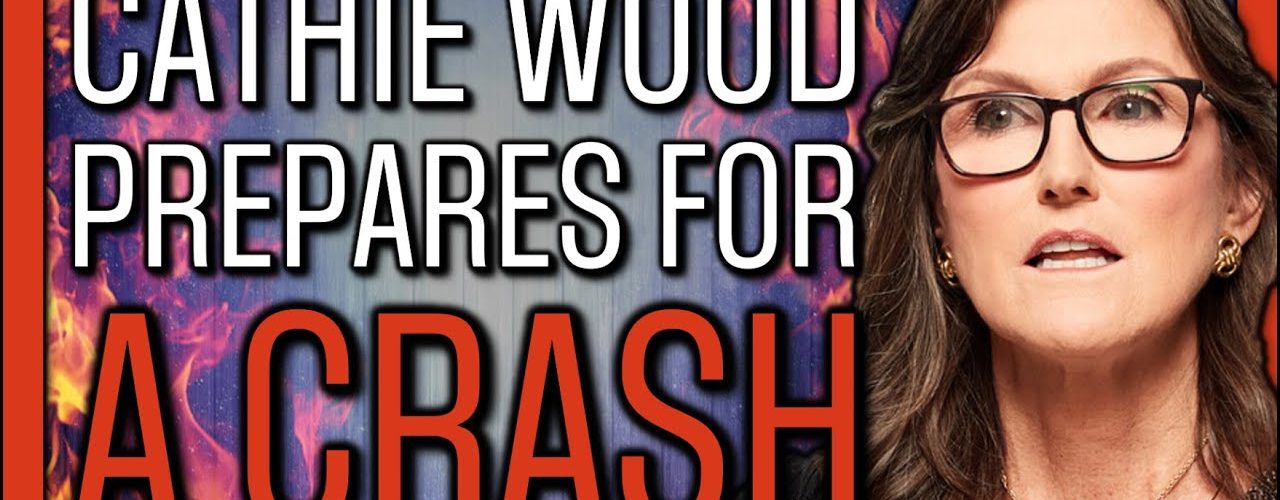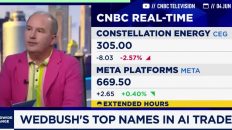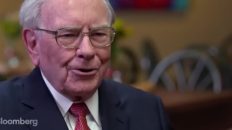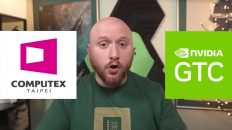Mentioned in Video:
- ARK Invest's ETFs:
- ARK Invest Innovation ETF (ARKK) – https://ark-funds.com/arkk
- ARK Invest Genomic Revolution ETF (ARKG) – https://ark-funds.com/arkg
- ARK Invest Autonomous Technology & Robotics ETF (ARKQ) – https://ark-funds.com/arkq
- ARK Invest Next Generation Internet ETF (ARKW) – https://ark-funds.com/arkw
- ARK Invest Fintech Innovation ETF (ARKF) – https://ark-funds.com/fintech-etf
- Support the channel and get extra member-only benefits by joining us on Patreon: https://www.patreon.com/tickersymbolyou
Is this a stock market crash or correction? What will Cathie Wood do when Tesla stock and SPCE stock are down 10% or more?! Can we dig through ARK Invest's data to see if the ARK will sink or swim?
Video Transcript:
[00:00:00.440]
Closing down three and a half percent for the day.
[00:00:04.410]
How much farther do we have to go down? It's finally dawning on people that we're in a real crisis here.
[00:00:10.390]
This is fine.
[00:00:11.190]
We'll have to go through our ups and downs and certainly with valuations where they are right now. I'm sure we're going to go through a doozy of a correction this year.
[00:00:21.310]
I have a confession to make. I used to be an emotional investor. I used to click every YouTube video mentioning an impending market crash and then panic sell great stocks at bargain basement prices. I was that guy. I've held everything from Nvidia to Square to Bitcoin to Tesla years ago, and I let them all go for a fraction of what they're worth today. These are the same stocks Cathie Wood is talking about buying. Who knows? She may have even bought some of them from me. Oof. Panic selling comes from a lack of psychological wherewithal that's the self discipline that apes like me
[00:00:59.990]
call Diamond Hands. That lack of discipline shows up in your portfolio's performance as the behavior gap, which is simply the difference between your actual returns and what your returns would have been if you did nothing after you bought a stock. Literally nothing.
[00:01:15.560]
By not doing anything, you outperform almost every donkey out there. All you need to do was do nothing.
[00:01:22.160]
This isn't just good advice from Chicken Genius Singapore. It's great advice. And the top comment under this video is gold as well. “Your portfolio is like a bar of soap. The more you touch it, the less you have.” Here's a quick and funny story. In 2008, Warren Buffett issued a challenge to the hedge fund industry. He bet a million dollars that after fees, costs and expenses an S&P 500 index fund would outperform a handpicked portfolio of hedge funds over ten years, basically pitting passive investing against active investing.
[00:01:53.190]
Ted Seides, a cofounder of Protegé partners, accepted the bet and then conceded in 2015, more than two years before the bet was scheduled to end, because he realized that he couldn't outperform the index over such a long time horizon. Warren Buffett understands the power of doing nothing until you're sure that doing something is actually the better option. This clip from HBO's documentary on Warren Buffett really says it all.
[00:02:18.090]
When I got to school.
[00:02:19.460]
I started selling stocks I was 20 years old at the time and looked about 16.
[00:02:24.060]
And acted about twelve, so I was not the most impressive salesperson anybody ever met.
[00:02:29.180]
What I would do is I went through page by page looking for possibly unvalued stocks.
[00:02:35.160]
Is this like going through an old family album?
[00:02:37.780]
Better.
[00:02:39.080]
That's the sort of self discipline we should all aspire to. Every year SNP Dow Jones Indices does a study on active versus passive management. In 2019, they found that after ten years, 85% of actively managed funds Underperform the S&P 500, that number jumps to 92% at the 15 year mark. These are professional money managers with cutting edge software and market models, and they're basically getting paid to Underperform a passive index. Isn't that crazy? Around 90% of us retail investors fail to beat the market after just one year. Over a ten year time horizon,
[00:03:16.270]
the amount of us that successfully beat an index by any meaningful amount is most likely approaching zero. Even if you don't include the cost of the time you spent researching and investing. This investor behavior gap isn't small either. In the ten years between 2009 and 2019, the average investor underperformed their own stocks by around 40%. Four zero. What this tells us is that our poor performance isn't because we're bad at picking stocks. It's because we're bad at what comes after. And by the way, you can have a positive behavior gap, meaning you can outperform the return of the stock by buying low and selling high more than once in a given time period.
[00:03:56.800]
When Cathie Wood says ARK Invest trades around volatility, that's exactly what she's doing: actively managing her funds when she thinks she can make a meaningful contribution above the returns of her holdings themselves. So let's ask the big question, how does a seasoned visionary investor like Cathie Wood prepare for a crash?
[00:04:16.210]
What we've been doing for the last six months is expanding the number of names in our portfolio. And we do that as a bull market extends because in some ways, it's a tax efficient strategy. What we will do during a correction, especially a severe correction like the coronavirus crisis presented, we will sell names, which are creating losses now because again, we bought them. We've diversified and bought them more recently. Sell those names, creating losses to buy our highest conviction names. So we're using them as cash like instruments in some way, because we will move back into our pure play names if we get into a severe correction.
[00:05:04.790]
But we also see the investment merit in these names. They're just not pure play names. So we use corrections toggling back and forth.
[00:05:13.260]
And so right now.
[00:05:14.420]
Our flagship portfolio has roughly 52 names in it. At the low point in the Coronavirus last year, it was as low as 33, I believe.
[00:05:25.790]
Whoa. There's a lot of good information here, but one thing really stands out. Cathie said that in the market lows of March 2020, ARKK had 33 stocks in it. These are their highest conviction pure play names. So let's take a look at how many names are in each of ARK Invest's five funds today. I'm calling this the Cathie Indicator. Each row in this table is one of ARK Invest's actively managed ETFs, and they're ordered with the biggest fund on top. ARKK represents about 47% of all the dollars in the five ARK funds.
[00:05:57.200]
ARKG represents about 21%, and so on. Each column represents market closes on a Friday going back to the start of November. Each cell in the table shows how many stocks were held in that fund on that date, and the colors show us how close or far away the fund is from holding exactly 33 stocks, according to Cathie Wood, and now the Cathie Indicator, ARKK having 33 stocks means that ARK Invest is almost totally out of all of their cash like positions and invested only in their highest conviction
[00:06:29.810]
pure play names. That is a position they would only put themselves in when they feel the market is at its bottom. Like in March of 2020. That's when you would want to spend all of your cash, right? So the more stocks above 33 that get added to ARKK, the more cash-like positions Cathie Wood is holding in that fund. By the way, this is the most amount of stocks I've seen in ARKK since I started this channel. This isn't financial advice and I'm not a financial advisor.
[00:06:58.290]
I personally am using the Cathie indicator as a proxy for Cathie Wood's outlook on the market. The more stocks in ARKK, the more cash-like her position appears to be. The more cash like her position, the more she is expecting an opportunity to spend it relatively soon.
[00:07:15.220]
It never hurts to take profits and to keep some powder dry so that you have the psychological wherewithall when the world seems to be falling apart to pick up on bargain basement prices and the more cash-like her position is,
[00:07:31.790]
the more I should consider keeping some powder dry for my own buying opportunities, which tend to be in the same areas as ARK Invest's: artificial intelligence, energy storage, robotics, DNA sequencing, and blockchain technology. That's why this indicator might be a good fit for me personally. There are a couple of things worth noting here. While each of the five funds stands alone, they have a good amount of overlap in terms of holdings. In fact, one of the special things about ARKK is it contains zero unique stocks. It only holds stocks in one or more of the other four funds.
[00:08:05.950]
ARKG and ARKW, the next two biggest funds, are also carrying a lot of extra stocks these days. That could be useful to know, because if the rise in the amount of companies in ARKK always comes after additions to ARKG or ARKW first, following this Cathie Indicator for ARKG and ARKW might alert you sooner that it's time to start building up cash. As you can see, Cathie Wood really started crash prepping in December of 2020, in ARKW and then ARKG, and then in ARKK throughout January of 2021.
[00:08:39.190]
It's a slow, calculated, multiweek, multi-fund process that we can observe. I will be watching all five funds like a hawk in the coming weeks to see when she starts selling stocks, which stocks she ends up selling, which stocks she keeps, and what the new positions inside each fund will be. I'll post followup videos as I find new and exciting things to share. Comment below or tweet me your thoughts on this Cathie indicator and your other favorite market indicators. Are you looking at volatility, sentiment surveys or something else entirely?
[00:09:09.630]
If you've experienced a market crash before, share the things that helped you through it, the whole community will thank you and I'd love to hear about it because all of this information helps guide my research and organize my own thoughts about these companies as well as how and when I should invest in them. The good news is if you've been watching this channel for a while, you might already be feeling more confident in your portfolio than before. Don't get me wrong, I'm not a financial advisor, and nothing I say here is ever financial advice.
[00:09:37.030]
Your confidence is not because of me. It's because you are using my channel and others as data points in your own investing vision until you are confident enough to put your money where your mouth is. To borrow from Stephen Mark Ryan, this matters. Wait, can I do that? Anyway, that's what Ticker Symbol: You is really all about. Helping you clarify your vision for the future and your investment thesis in it so that you can take advantage of the buying opportunities you're confident in instead of them taking advantage of you.
[00:10:10.920]
Things like ARK Invest's Big Ideas and clusters of innovation platforms are just ways to help us organize our vision so we can clarify one piece at a time. From there, we match each piece, drones, digital wallets, DNA sequencing, whatever we're really excited about to the companies fulfilling that vision. You take the pieces that work for you and you pass on the ones that don't. What you should know, though, is that this is the first half of a big feedback loop. The market is always shifting. New technologies are being created, tested, refined and released every day, and they're changing the way we work, the way we play, the way we communicate and the way we travel while disrupting the companies that came before them.
[00:10:50.640]
So we're constantly progressing towards our own vision of the future, not only as the consumers who buy these products and services, but also as investors who keep up to date with the companies creating them, the market makers talking about them and the market forces affecting them. That's the other side of this feedback loop, keeping up with how the future is actually playing out and updating your vision and investment thesis accordingly. It's why Cathie Wood's conviction in a company can change over time. It's why ARK Invest added six new Big Ideas this year.
[00:11:23.220]
Just listen to how Chamath beautifully ties everything together in this recent episode of Investing for Profit and Joy with Howard Winson the cofounder of StockTwits.
[00:11:32.890]
Like if you ask me, Howard, like, Chamath, where could you make a ton of money in the future? Number one is understand technology. Number two is understand biotech. Now, biotech is much harder. But why those two? Because most of the innovations in technology. Now sit on top of three fundamental things that didn't exist ten years ago or really 15 years ago. AWS, and then all of its copycats, iOS and Android. Those are the only three things that really matter. And with that, you have every single great company, whether it's Snowflake to Twilio, to Facebook, to Instagram, to TikTok.
[00:12:08.280]
All sit on top of these three abstractions. Right? So it created an ecosystem that is just enormous, measured in the trillions of dollars. Well, if you wind the clock back, Biotech is actually at the same part of the curve now. You have delivery things like cart. You have implementation mechanisms like CRISPR. That's that's Biotech version of iOS, Android, AWS, so my point is…
[00:12:30.700]
That's cool.
[00:12:31.360]
If you have to figure out two or three areas that are just gonna skew positively and generate huge Alpha, those are two.
[00:12:39.100]
Now, those are two obvious areas that are not well suited for traditional buy side, for traditional, backwards-based forecasting. So the setup is amazingly good for retail because you are going to run circles around institutional capital.
[00:12:56.730]
This is why I'm confident in using ARK Invest as a jumping off point for my own ideas about the future and investing. That same confidence is what keeps me invested even when my technology focus portfolio looks like this. And that same confidence is what allows me to calmly reassess my vision. And if nothing has changed, continue to buy at bargain basement prices instead of selling like I used to. The point in sharing my failures and my framework with you is to help you slowly build that confidence as well.
[00:13:25.960]
Having confidence in my own vision as well as the data behind it gives me that psychological wherewithal to have strong hands in a volatile market. The next time Cathie Wood buys Square or Nvidia or Bitcoin or Tesla at bargain basement prices, it won't be for me. And maybe now not from you, either. This is Ticker Symbol: You. My name is Alex, reminding you that the best investment you can make is in you.
If you want to comment on this, please do so on the YouTube Video Here
